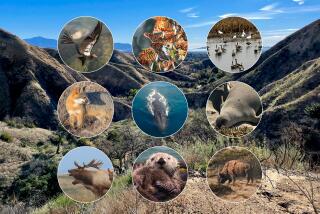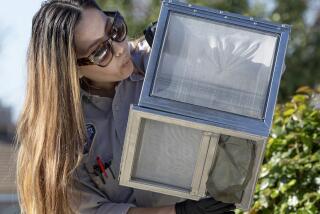Dapper black phoebe thrives on insects in flight
- Share via
I noticed a small bird following me as I walked through the knee-high grass at the edge of San Elijo Lagoon.
This dapper little black and white bird seemed quite friendly and interested in my travels. I’d stop and he’d land on a nearby tree or fence post until I started moving again. I then realized he was simply taking advantage of my movement.
As I walked, tiny insects were flying up from the disturbed grass, and my hiking companion was reaping the benefits. Launching from his perch, he would repeatedly swoop down and grab an insect in flight, and then move on to his next perch behind me.
On this trip, my little friend was a black phoebe, one of more than 400 tyrant flycatcher species found through the United States. The black phoebe is more localized, occurring from Southern Oregon, along the California coast, through the Southwest into Mexico and South America.
Resident to San Diego, the black phoebe is widely distributed here, found commonly from our coast to the highest mountain elevations and in concentrated areas of the desert.
The black phoebe is always associated with water since this is critical to provide a habitat for insect foraging as well as the necessary ingredient for nesting. This phoebe builds a bowl nest using small dabs of mud mixed with grass. It’s similar to the nest of barn swallows.
The black phoebe nest is plastered to the wall of sheltered places such as natural boulder overhangs, the eaves of a house, under bridges, in culverts or beneath building ledges. The inside of the nest is lined with softer material such as animal fur, or tiny roots and grasses. One to six eggs are laid in the nest, and the birds will produce up to three broods in a good year.
Nesting is a cooperative event, with the male giving his mate a selection of several nesting sites. The female chooses the location and builds the nest, but both birds protect and defend the nesting site. Once paired, the birds are generally monogamous.
They have adapted well to urbanization, taking advantage of urban parks and lawns as a source for insects and adopting livestock troughs, garden ponds or birdbaths as their water supply.
The black phoebe is easy to identify because of its distinctive sooty black and crisp white coloration and the stylish inverted V where his white underbelly meets the dusky black head, chest and wing color. Unlike many of the more nervous flycatchers, the black phoebe actually seems to enjoy hanging around people, maybe landing at the other end of a picnic table as if curious about your presence.
Local lakes, shoreline lagoons and parks with nearby water are all great places to spot the black phoebe and add him to your life list.
And, if you are wondering what they call a group of flycatchers, it can be an “outfield,” a “swatting,” a “zapper” or a “zipper.”
Hummingbird numbers
Several readers have written with comments and concerns about our hummingbird population because they are not seeing as many visitors to their nectar feeders this winter.
Bill Pickens wrote, “In Hidden Meadows we have noticed a sudden, dramatic drop in the number of hummingbirds at our feeders. Do you know why?”
The simple answer, according to Phil Unitt, editor of the San Diego County Bird Atlas and curator of birds at the San Diego Natural History Museum, is there is no apparent reduction in hummingbird population, based on annual bird counts.
“There was no dip in the number of Anna’s hummingbirds in Oceanside this past winter; if anything, a spike,” Unitt said.
There may be fewer birds visiting feeders because early and abundant rains have produced growth and insect hatches that are providing enough natural food for the little birds.
Oriole season
Speaking of feeders, it’s about time to put out oriole feeders. Hooded orioles will begin showing up later this month, with big numbers arriving in March.
The brightly colored orioles enjoy the same sugar water nectar you use for hummingbirds, but because of their larger beaks, they require a slightly different feeder. I’ve found the 32-ounce First Nature Oriole Feeder to be economical, easy to clean and popular with the orioles.
Cowan is a freelance writer based in Escondido. Email him at BirdandErnie@gmail.com or follow him at erniesoutdoors.blogspot.com.
More to Read
Sign up for The Wild
We’ll help you find the best places to hike, bike and run, as well as the perfect silent spots for meditation and yoga.
You may occasionally receive promotional content from the Los Angeles Times.










